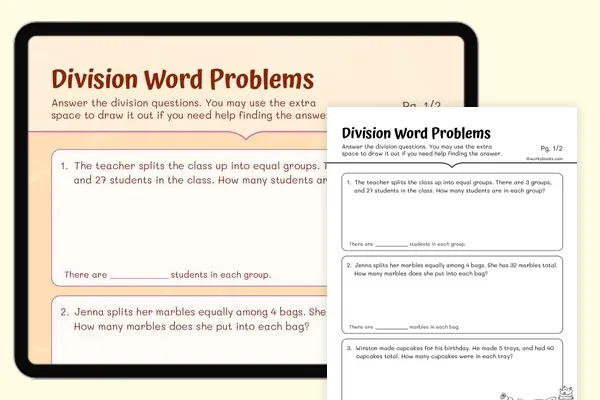Equal Groups Worksheet
- 3
- 3.OA.B.6
- 3.OA.A.1
- 3.OA.A.2
- 3.OA.A.3
- 3.OA.A.4
This learning resource is available in interactive and printable formats. The interactive worksheet can be played online and assigned to students. The Printable PDF version can be downloaded and printed for completion by hand.
About the "Equal Groups" Worksheet
Equal Groups is an engaging math worksheet designed to reinforce the fundamental concepts of multiplication and division through visual representation and practical application. This interactive and printable worksheet spans two pages and presents a series of problems where students must complete multiplication and division expressions based on groups of stars. The first problem is solved as an example, providing clear guidance on how to approach the subsequent questions.
The worksheet cleverly illustrates the relationship between multiplication and division using equal groups of objects, encouraging students to think about these operations in terms of real-world groupings. This interactive and printable worksheet enhances students' understanding of these crucial mathematical concepts by requiring them to fill in blanks for both multiplication and division expressions side by side. By doing so, students can grasp the inverse relationship between these operations. The visual nature of the problems, combined with the need to translate visual information into numerical expressions, makes this worksheet an effective tool for developing a deeper comprehension of multiplication and division principles.
What will your child learn through this worksheet?
- Understanding the concept of equal groups in multiplication and division
- Recognizing the inverse relationship between multiplication and division
- Translating visual representations into mathematical expressions
- Practicing multiplication and division with small numbers
Learning Outcomes
Cognitive
- Correctly complete at least 4 out of 5 multiplication and division expression pairs within 15 minutes
- Demonstrate understanding of the relationship between the number of groups, items per group, and total items in both multiplication and division contexts
Psychomotor
- Accurately count and represent the number of stars in each group
- Write numbers clearly and legibly in the provided spaces within the expressions
Affective
- Show increased confidence in approaching multiplication and division problems
- Demonstrate enthusiasm for discovering the connection between visual representations and mathematical operations
Interpersonal/Social
- Engage in discussions with peers about different strategies for counting equal groups and forming expressions
- Collaborate with classmates to check answers and explain reasoning for completed expressions
Tags
equal groups, multiplication, division, visual math, arithmetic operations, mathematical relationships, elementary math, math worksheets, problem-solving, number sense
Common Core Standards Covered
Perfect For:
- • Classroom assignments
- • Auto-graded assessments
- • Printable handouts
- • Home learning support
- • Homework help
- • Skill reinforcement
- • Curriculum planning
- • Self-paced learning
- • Progress tracking




















